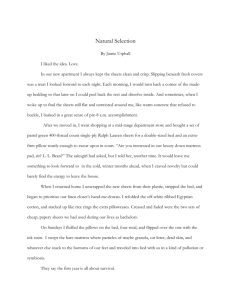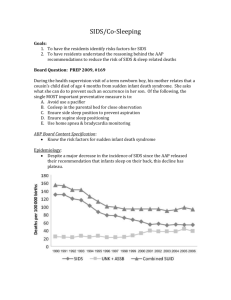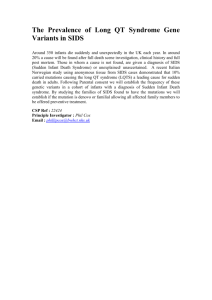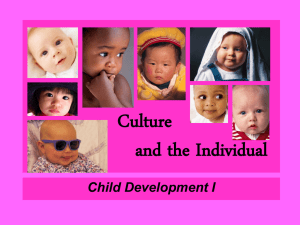Essay2
advertisement
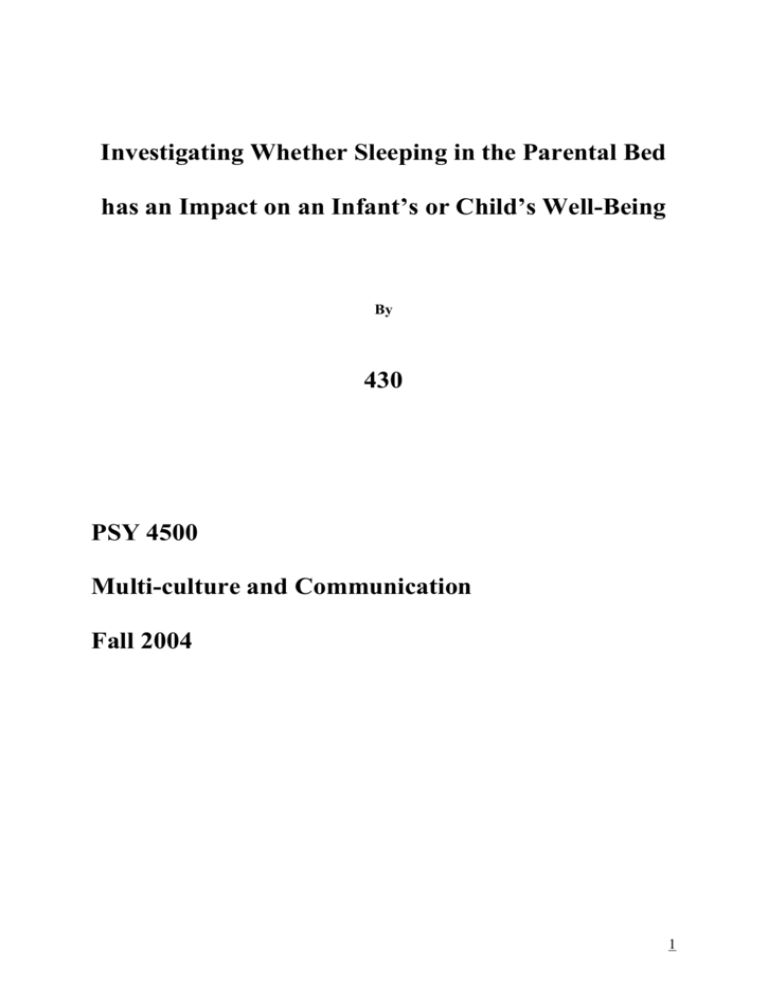
Investigating Whether Sleeping in the Parental Bed has an Impact on an Infant’s or Child’s Well-Being By 430 PSY 4500 Multi-culture and Communication Fall 2004 1 In a majority of the world’s cultures, babies usually sleep with their mothers or at least in the same room as their mothers. However, in a minority of cultures, such as for example the middle-class in the United States, it is thought that babies should be put to sleep in a separate bed, preferably in their own room. Historically however, co-sleeping was also common in the United States (Morelli et al., 1992). Among the middle-class in the US it is generally believed that it is important for infants to sleep separately from their parents in order to foster independence and promote healthy psychological development. Since the early 1900s, parents in the US have been told by child-rearing experts that it is harmful to bring their children to bed with them. (Morelli et al., 1992). However, this advice has been based on a belief, and not on evidence. And while “several accounts now acknowledge the value placed on co-sleeping by some families (Brazelton, 1990), or advocate the practice (Thevinin, 1976), pediatricians generally advise parents to avoid cosleeping” (Morelli et al., 1992, p. 604 citing Lozoff, Wolf & Davis, 1984). In a study comparing middle-class US (where solitary sleeping is the norm) and Mayan (where bed-sharing is the norm) parents’ decisions regarding sleeping arrangements for their children’s first two years, US parents explained that it was important that children learn independence early on by sleeping alone. Mayan parents explained that bed-sharing helped them achieve their goal of establishing a close relationship. The Mayan parent’s reactions to the US custom of sleeping separately indicated that they thought the practice was the equivalent of child neglect. In contrast, the family and community members of the few US parents who were not sleeping separately expressed surprise and concern about the consequences on the infants’ and parents’ well-being. The parents themselves were unhappy with the arrangement and knew they were violating cultural norms. (Morelli et al., 1992). Some question the widely held western belief that solitary sleeping promotes independence. For example, if children who sleep alone truly are more independent, it is “perhaps surprising that during historical periods in the US in which “independence” was most vividly demonstrated, such as the colonial period or the westward movement, children were not likely to fall asleep alone” (Morelli et al., 1992, p. 611, quoting Wolf & Lozoff, 1989, p. 292). It could be more difficult for infants and young children who sleep alone to separate from their parents during the day, rather than easier (Morelli et al., 1992 citing a personal communication with E.Z. Tronick). It is an interesting paradox that “independent solitary sleepers” require more complex bedtime rituals and depend on security objects and sleep aids more than “dependant co-sleepers”. (Hayes et al., 1996). In order to achieve independent sleeping, US 2 parents may feel obligated to let their children “cry it out” instead of going to them when they cry. For example, in Morelli et al.’s study “[o]ne mother reported putting a pillow over her head to drown out the sounds of her crying baby as she fell asleep – consistent with the advice of some child-rearing specialists (such as Ferber 1986)”. The transition to sleep often causes conflict and is stressful for both children and parents in the US. (Morelli et al., 1992). A study comparing Sami and Norwegian four-year-olds challenges western culture’s belief that solitary sleep is positively correlated with independence. Significantly more Sami children than Norwegian children slept with their parents, and yet the Sami children were able to play alone without demanding their parent’s attention significantly longer than the Norwegian children. They also wanted to be babied less by their parents. (Javo et al., 2004). Although co-sleeping is thought to be a violation of a cultural norm in the US, cosleeping is becoming more prevalent in the US. The results of a telephone survey of random samples of nighttime caregivers of infants born within 7 months of the interviews conducted between 1993 and 2000, revealed that 45% of the infants had spent some time in an adult bed during the two weeks prior to the interview. Between 1993 and 2000 the proportion of infants usually sharing a bed with an adult increased from 5.5% to 12.8% (Willinger et al., 2003). The proportion of infants who routinely co-sleep is also increasing in Norway (Arnestad et al., 2001). It is also possible that parents under-report the prevalence of co-sleeping since the practice is frowned upon and they may not want to admit to it. Also, babies who spend the majority of the night in the parental bed could be classified as solitary sleepers in studies that only look at where the baby is initially put to bed (Ball et al., 1999). Another factor that complicates establishing the prevalence of co-sleeping is that the definition of co-sleeping seems to vary from study to study (Rath & Okum, 1995). For example, a study that has been cited in support of the benefits of co-sleeping indicated that “cosleepers” had greater self-esteem, self-integration and generally better physical and mental well-being (McKenna, 2000). However, in this study, co-sleeping was defined as either sleeping in the same bed as the parent or in a separate bed in the same room. The author of this study also points out that these benefits are limited to the “separate bed same room” situation, and to situations where the children have not viewed parental intercourse (Crawford, 1994). There are often references in the literature to concerns that co-sleepers are more likely than solitary sleepers to be subject to sexual abuse. However, research does not support this view (Rath & Okum 1995). And, the author of this paper is unaware of any reason to believe that the prevalence of sexual abuse is higher in cultures where co-sleeping is the norm, or that it was more common in the US before solitary sleeping became the norm. 3 There does not seem to be any consensus on the benefits or detriments of co-sleeping. In a study of psychiatric outpatients from an American inner-city population, co-sleeping was reported in 18% of the households. Compared to pediatric and non-patient samples, cosleeping rates were higher among older children in the psychiatric sample. A majority of the reasons given for co-sleeping inferred a lack of comfort with autonomy on the part of the patient or the parent (Rath & Okum, 1995). Another study comparing a population of psychiatric vs. pediatric military dependants revealed that “children who had not had previous “professional attention for emotional or behavioural problems” co[-]slept more frequently than did the children who were known to have had psychiatric intervention and lower parental ratings of adaptive functioning” (Forbes et al., 1992). Turning to a sample of college psychology students, a retrospective survey found that males with a history of sleeping with their parents had higher self-esteem, less guilt and anxiety and reported greater frequency of sex. Females with a history of sleeping with their parents during childhood reported increased comfort with physical contact and affection and increased sexuality. Interestingly, in response to specific questions about sleeping in the parental bed, not one subject reported any negative experiences. Lewis and Janda report that “a representative comment for both men and women was “It always gave me a feeling of security to know that if I had a bad dream I could crawl into bed with my mom and dad.” (Lewis & Janda, 1988). Dr. McKenna argues that advocates of early solitary sleeping arrangements based on alleged benefits such as greater independence, social competence, self-esteem, etc., have not documented these benefits through scientific studies, and suggests that co-sleeping may actually contribute to these characteristics. As an example, he points out that a study of English children found that children who never slept in their parents’ beds were more likely to be harder to control, less happy and to exhibit greater tantrums than children who were allowed into the parental bed. They were also more fearful and more dependant on their parents than children who always slept in their parents’ beds (McKenna, 2000, citing Heron, 1994). He also generally criticizes western research for being culturally biased against co-sleeping and points out that research is typically limited to samples of solitary sleeping bottle or minimally breast fed infants. He argues that “[b]y using data from only one type of sleeping arrangement and implying that there is only one context within which healthy infant sleep emerges, i.e., the solitary one, pediatric sleep research is thus held captive by Western ethnocentrism” (McKenna, 2000). 4 A study done by Dr. McKenna et al., 1997, found that babies, who routinely share a bed with their mothers, are breastfeed more frequently and for longer periods during the night than babies who do not routinely share a bed with their mothers. While they did not collect information about daytime feedings, they pointed out that available data does not provide any evidence indicating that daytime feeding is reduced by nighttime feedings. This could have a significant positive impact on an infant’s well-being as there is “near universal agreement that increased breastfeeding reduces infant morbidity and mortality worldwide.” (McKenna et al., 1997) Additionally, bed-sharing gives the parents more opportunities to monitor the wellbeing of the child, which could increase its chances of survival (Mosko et al., 1997). In the popular media in cultures where solitary sleeping is the norm, and also in some reports of studies done in those cultures, reducing the risk of Sudden Infant Death Syndrome (SIDS) is often cited as a reason why infants should not sleep in the same beds as their parents. However, people from a culture where co-sleeping is the norm probably think the opposite. For example, in a case reported in the news in San Jose, California, a 5-week-old infant of a family from the Iu Mien tribe of Southeast Asia died while in foster care. Members of the family’s community were outraged because babies from their culture always sleep in their parents’ beds with them. (Rogoff, 2003). Interestingly, in Japan and Hong Kong, where cosleeping is common, the SIDS rates are much lower than the rates found in for example the US, where solitary sleeping is the norm (Davies, 1994). Of course, it is possible that cultures that value co-sleeping under-report SIDS cases. On the other hand, the research done on SIDS and co-sleeping is typically done in the minority of cultures (western industrialized cultures) where co-sleeping is viewed as abnormal, and consequently it is probably culturally biased. The question of whether co-sleeping is a risk factor for SIDS is controversial. Some studies have shown an increased risk of SIDS associated with co-sleeping, others have shown no significant relationship and others have suggested that co-sleeping is protective for infants at risk for SIDS. (Arnestad et al., 2001). The conservative American Academy of Pediatrics (AAP) takes the middle ground and finds that there “are insufficient data to conclude that bed sharing under carefully controlled conditions is clearly hazardous or clearly safe.” The AAP does say that bed-sharing may be hazardous in certain conditions, and that if you bed-share, the following precautions should be taken: Infants should sleep in the non-prone sleeping position, soft surfaces or loose covers should be avoided, entrapment should be avoided by moving the bed away from the wall and other furniture that present entrapment possibilities, no one besides the parents should share a bed with the baby, bed-sharing parents should not smoke or use other substances such as alcohol or drugs, that may impair arousal, and overheating should be 5 avoided. The AAP points out that their recommendations are meant primarily for healthy infants, and that individual medical conditions may warrant a physician, after weighing risks and benefits, to recommend otherwise (AAP, 2000). Some research has found that bed-sharing is a risk factor for SIDS, but this research does not seem to differentiate between bed-sharing practiced under safe conditions and bedsharing without taking safety precautions (see criticism by O’Hara et al., 2000). In some studies, infants sleeping alone in an adult bed, or even on sofas or chairs are included in the cosleeping category, which is compared to infants sleeping alone in cribs (McKenna 2001). What does appear to be undisputed is that bed-sharing without taking precautions does put an infant at greater risk (Gessner et al., 2001). Also, parents and infants sharing a room but sleeping in separate beds is protective against SIDS compared to solitary sleeping (Scragg et al., 1996). Some research has indicated that bed-sharing might be protective against SIDS. Bedsharing may reduce the amount of time an infant spends in deep sleep thereby increasing infant arousability and possibly protecting against SIDS (Mosko et al., 1997). The mother’s responsiveness in the bed-sharing situation may also be protective. (Mosko et. al., 1996). The mother’s breathing may also “trigger” the infants breathing, and may help regulate the infants breathing (Richard, 1998). However, further research needs to be done in order to find out whether parents sharing a bed with an infant, as an isolated factor, under the conditions recommended by the AAP, is protective, hazardous or of no significance for the infant’s safety. The fact that a substantial minority of parents share a bed with their infants in western cultures despite the cultural taboo against bed-sharing, suggests that these parents may often be doing it out of perceived necessity rather than desire, and they may feel that they or their infant has somehow failed. The increasing proportion of bed-sharers in cultures like Norway and the US may be related to the increasing prevalence of breast feeding. Parents may share a bed with their infants in order to facilitate breast feeding or they may use bed-sharing in order to solve their family’s “sleeping problems” because for example letting their child “cry it out” did not work or they viewed bed-sharing as the lesser of two evils. Bed-sharing is often viewed as problematic sleeping behaviour in cultures like the US and Norway, but problematic sleep behaviour “is problematic only in relation to our society’s expectations, rather than to some more general standard of what constitutes difficult behaviour in the young child” (McKenna, 2000, citing Lozoff et al., 1985). As the issue of the impact of bed-sharing on an infant or child’s well-being is unresolved and is such an important issue for expectant parents, more research is needed. As a 6 child or infant’s well-being is influenced by many factors, it is extremely difficult to look at bed-sharing as an isolated factor. It may be that bed-sharing has little or no impact on a child or infant’s well-being, and it may be other factors that are often correlated with bed-sharing, such as breast feeding, or the feeling of success or failure of the bed-sharers, or the sensitivity of the parents to the child’s needs, or the temperament of the child, or the consistency or lack of consistency in sleeping arrangements etc., are significant. All these issues make it difficult to interpret the results of the various investigations into sleeping arrangements, especially in combination with the various definitions of co-sleeping used. Hopefully further research can clarify some of these issues, and as much as possible separate the variables. In a culture such as the mainstream Norwegian culture where solitary sleeping is the norm despite the fact that the prevalence of breast feeding is high compared to other western cultures, it would be interesting to compare the well-being of infants in the following four groups: 1) sleeping in a separate room from their parents, 2) sleeping in a separate bed but the same room as their parents, 3) sleeping in the same bed with parents who do not want to share a room with their infants, and 4) sleeping in the same bed with parents who do want to share a room with their infants. As mentioned, there probably are differences between “willing bedsharers” and “reluctant or ambivalent bed-sharers”, so these two groups should be investigated separately. As far as the author of this paper knows, this has not been done before within the same culture. These issues could initially be investigated by questioning a random sample of expectant Norwegian parents about where they expect their babies to sleep and how they feel about various sleeping arrangements, and then following up about 6 months after their babies’ births with questions about where their babies actually sleep, how they feel about the sleeping arrangements and general investigations into the overall mental and physical health of their babies. Ideally these participants would be followed up some years later with interviews and tests aimed at finding out about later sleeping arrangements, independence, and overall physical and mental health. It would also be very interesting to scrutinize the death certificates of any deaths occurring before age 2 or 3 and comparing SIDS and suffocation rates between the 4 groups. And in cases where an infant died of SIDS or suffocation while co-sleeping, it would be important to find out whether or not they were regular bed-sharers and whether or not they practiced bed-sharing in accordance with the guidelines outlined by the AAP. These results could hopefully help parents make informed choices about sleeping arrangements, and help health care providers give advice based on scientific evidence rather than folk myth, and possibly lead to further research on the subject. 7 REFERENCES American Academy of Pediatrics, Task Force on Infant Sleep Position and Sudden Infant Death Syndrome, (2000). Changing Concepts of Sudden Infant Death Syndrome: Implications for Infant Sleeping Environment and Sleep Position. Pediatrics. 105, 650 –656. Arnestad, M., Andersen, M., Vege, Å., Rognum, T. O., (2001). Changes in the epidemiological pattern of sudden infant death syndrome in southeast Norway, 1984-1998: implications for future prevention and research. Arch. Dis. Child, 85 108-115. Ball, H. L., Hooker, E., Kelly P. J., (1999). Where will the Baby Sleep? Attitudes and Practices of New and Experienced Parents Regarding Cosleeping with Their Newborn Infants. American Anthropologist, 101, 143-151. Crawford, C.J., 1994). Parenting Practices in the Basque Country: Implications of Infant and Childhood Sleeping Location for Personality Development. Ethos 22, 42-82. Davies, D. P., (1994). Ethnicity and the sudden infant death syndrome: an introduction. Early Human Development 38 139-141. Forbes, J. F., Weiss D. S., Folen, R. A., (1992). The Cosleeping Habits of Military Children. Military Medicine, 157, 196-200. Gessner, B. D., Ives, G. C., Perham-Hester, K. A., (2001). Association Between Sudden Infant Death Syndrome and Prone Sleep Position, Bed Sharing, and Sleeping Outside an Infant Crib in Alaska. Pediatrics, 108, 923-927. Hayes, M. J., Roberts, S. M., Stowe, R., (1996). Early Childhood Co-Sleeping: Parent-Child and Parent-Infant Nighttime Interactions. Infant Mental Health Journal, 17 348-357. Javo, C., Rønning, J. A., Heyerdahl, S., (2004). Child-rearing in an indigenous Sami population in Norway: A cross-cultural comparison of parental attitudes and expectations. Scandinavian Journal of Psychology, 45 67-78. Lewis, R. J., Janda, H. J., (1988). The Relationship Between Adult Sexual Adjustment and Childhood Experiences Regarding Exposure to Nudity, Sleeping in the Parental Bed, and Parental Attitudes Towards Sexuality. Archilves of Sexual Behavior, 17, 349-362. McKenna, J. J., Mosko, S. S., & Richard, C. A., (1997). Bedsharing Promotes Breastfeeding. Pediatrics 100, 214-219. McKenna, J. Cultural influences on infant sleep biology and the science that studies it: toward a more inclusive paradigm. In Sleep and Breathing in Children: A Developmental Approach (2000). Eds. Loughlin, G., Carroll, J., Marcus, C., (Eds.), Marcell Dakker (pp. 199-230) New York: Marcel Dekker, 2000. McKenna, J. J., (2001). Why We Never Ask “Is It Safe for Infants to Sleep Alone?” Historical Origins of Scientific Bias in the Bedsharing SIDS/SUDI ‘Debate’, ABM News and Views, 7 32 & 38. 8 Morelli, G.A., Rogoff, B., Oppenheim, D., & Goldsmith, D. (1992). Cultural variation in infants’ sleeping arrangements: Questions of independence. Developmental Psychology, 28, 604-613. Mosko, S., Richard, C., & McKenna, J., (1997). Infant Arousals During Mother-Infant Bed Sharing: Implications for Infant Sleep and Sudden Infant Death Syndrome Research. Pediatrics, 100, 841-849. Mosko, S., Richard, C., & McKenna, J., (1997). Maternal sleep and arousals during bedsharing with infants. Sleep 20(2): 142-150. Mosko, S., Richard, C., McKenna, J., & Drummond, S., (1996). Infant Sleep Architecture During Bedsharing and Possible Implications for SIDS. Sleep, 19, 677-684. O’Hara, M., Harruff, R., Smialek, J. E., Fowler, D. R;., Drago, D. A.;, McKenna, J. J., Gartner, L. M.;, Drago, D. A.;, Servan-Schreiber, D.;, & Drago, D. A., (2000). Sleep Location and Suffocation: How Good Is the Evidence? Pediatrics, 105, 915-920. Rath, R. H, Okum, M. E., (1995). Parents and Children Sleeping Together: Cosleeping Prevalence and Concerns. Amer. J. Orthopsychiat.65, 411-418. Richard, C. A., Mosko, S. S., McKenna, J. J., (1998). Apnea and periodic breathing in bedsharing and solitary sleeping infants. J. Appl. Physiol. 84 1374-1380. Rogoff, B. (2003). The cultural nature of human development. New York: Oxford University Press. Scragg, R. K. R., et al., (1996). Infant room-sharing and prone sleep position in sudden infant death syndrome. Lancet, 347, 7-12. Willinger, M., Ko, C. W., Hoffman, H. J., Kessler, R. C., Corwin, M. J., 2003). Trends in Infant Bed Sharing in the United States, 1993-2000. Arch. Pediatr. Adolesc. Med. 157, 43-49. 9


